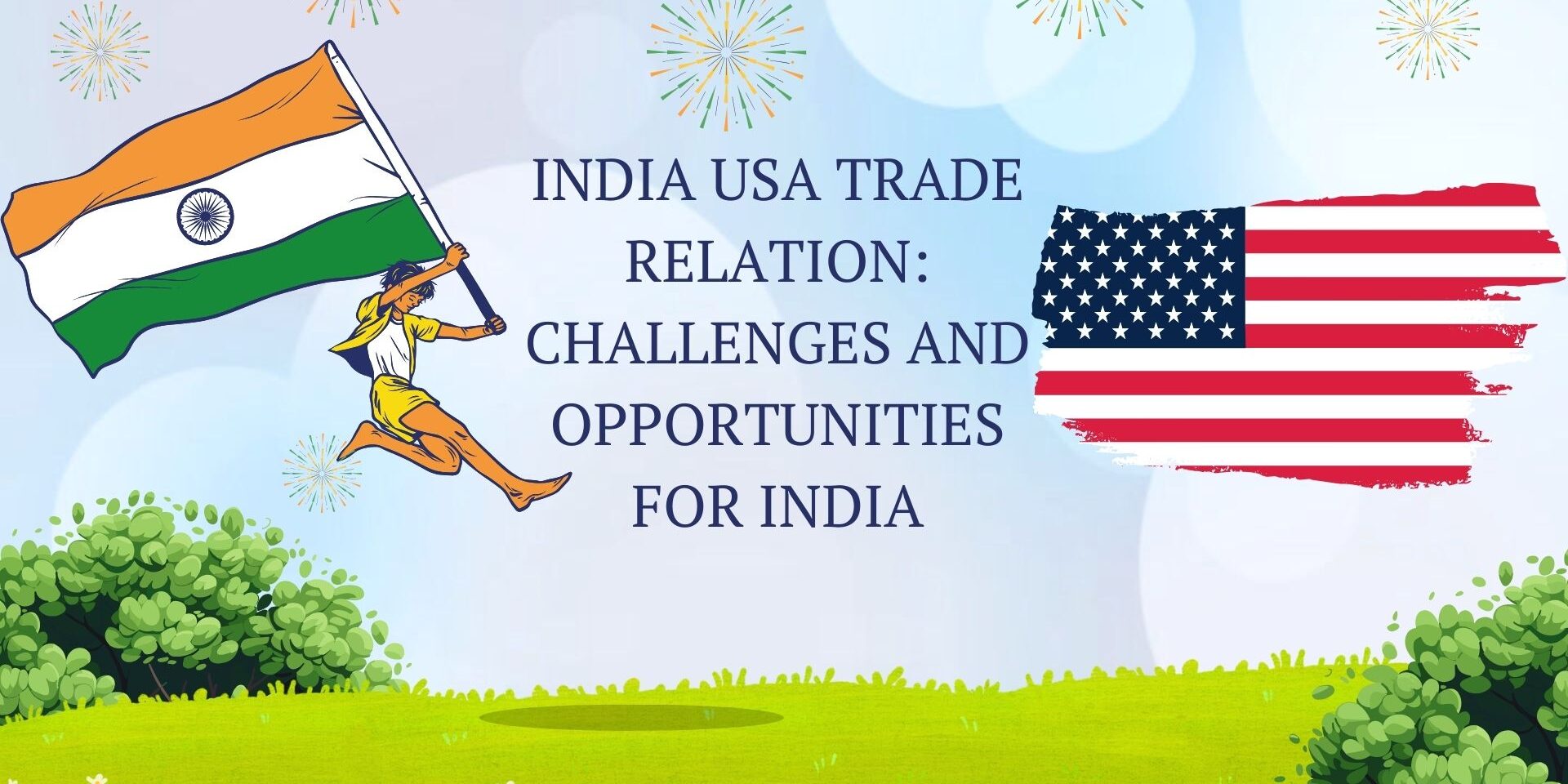-By Nishant Chaturvedi
Abstract: This research paper explores the evolution of India-US trade relations, examining their past, present, and future trajectories. It begins by tracing the historical context of bilateral trade, highlighting key milestones and shifts in policy that have shaped the relationship over the decades. The current state of trade is analyzed, focusing on major sectors, trade volumes, and existing challenges such as tariffs, regulatory hurdles, and geopolitical tensions. Additionally, the paper identifies emerging opportunities for collaboration in areas like technology, climate change, and healthcare, which are poised to redefine the partnership. This paper aims to comprehensively understand how the past influences the present. It shapes the future of this critical economic partnership, offering insights into strategies for enhancing mutual benefits.
Keywords: Tariffs, Geopolitical, Economic Partnerships.
Introduction: India and the United States have had ties since India’s fight for independence. Their relationship grew after India became independent from Britain in 1947. Today, both countries trade extensively and are among the world’s top trading partners. India is the USA’s tenth-largest trading partner in 2023, although the USA surpassed China to become India’s top trading partner in 2022-23. According to the Ministry of Commerce and Industry, the two countries bilateral trade stood at US$ 118.2 billion in FY 2024. Major exports to the US include engineering goods, electronic goods, gems and Jewelry, pharmaceutical products, light crude oil and petroleum, and electrical.
Volume of Trade With the USA: The graph below reflects steady trade growth between the two countries, with cumulative trade volume going up from $63.7 billion in 2013 to $129.2 billion in 2024. In 10 years, trade increased by over 200% in rupee terms and over 95% in dollar terms. Indian exports to the U.S. have also increased steadily, reaching $87.4 billion in 2024. Likewise, U.S. exports to India have grown, reaching $48.5 billion in 2022 before dropping slightly to $41.8 billion in 2024. The balance of trade has overwhelmingly favored India, with the U.S. merchandise trade deficit with India standing at $45.6 billion for 2024, an increase of 5.3% from 2023.
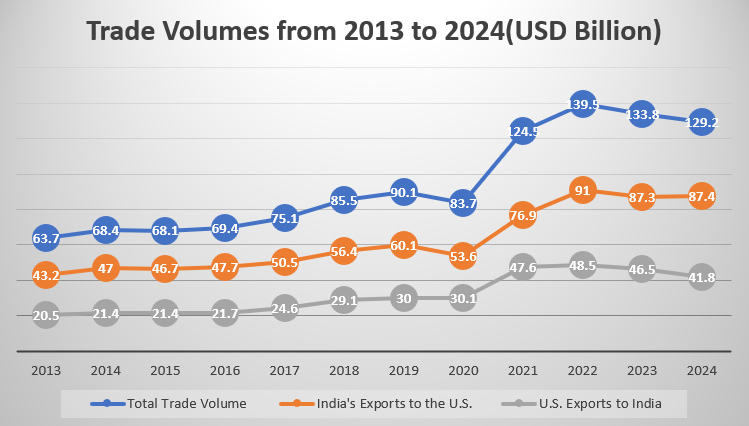
Source – oec.world, statista.com
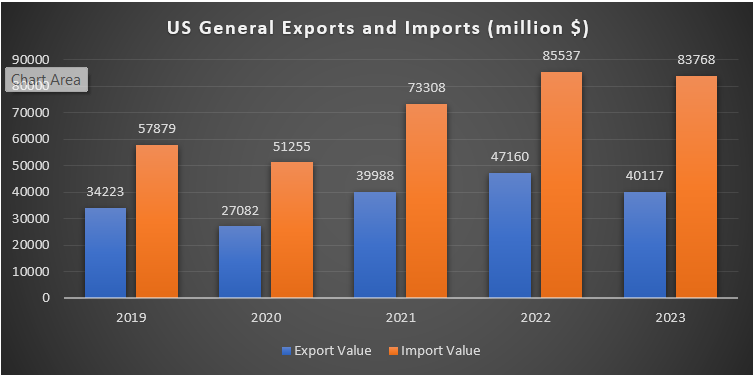
Source – USITC DataWeb/Census, accessed February 16, 2024.
Composition of Trade-
In 2021, of the $40.1 billion in U.S. exports to India, the top commodity sectors were Oils, Minerals, Lime, and Cement (34.3%), Stone, Glass, Metals, and Pearls (18.4%), and Chemicals, Plastics, Rubber, and Leather products (13.9%). In 2021, of the $73.3 billion in U.S. imports from India, the top commodity sectors were Stone, Glass, Metals, and Pearls (23.3%), Chemicals, Plastics, Rubber and Leather products (23.0%), and Textiles, Footwear, and Headgear (14.9%).
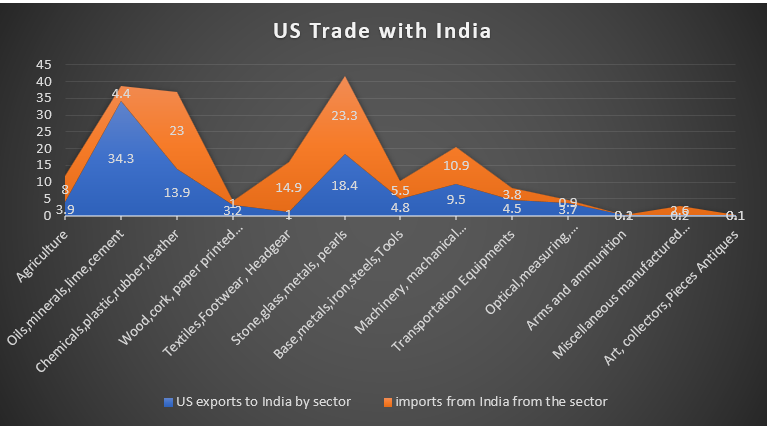
Source – The Share of U.S.–India Trade to the U.S. Global Trade.
Major exported items from India to the USA with amount & quantity
During FY24, India shipped 7,346 commodities to the United States, with exports totalling US$ 77.5 billion. The key items exported were Engineering goods (US$ 17.6 billion), Electronic goods (US$ 10.0 billion), Gems and Jewellery (US$ 9.90 billion), Drug formulations and biologicals (US$ 8.72 billion), Petroleum products (US$ 5.83 billion), and RMG cotton including accessories (US$ 4.71 billion). In April-November 2024, India’s exports to the US were US$ 52.95 billion, with the major exports being Engineering goods (US$ 12.33 billion), Electronic goods (US$ 6.79 billion), Drugs and Pharmaceuticals (US$ 6.34 billion), Gems and Jewellery (US$ 6.28 billion), and RMG cotton including accessories (US$ 3.32 billion). These numbers point towards increasing trade partnership between the US and India, with engineering and electronics dominating the export sector.
Major imported items by India from the USA with amount & quantity
India imported 5,749 products from the United States in FY24, with imports increasing to US$ 40.7 billion. The top imports were mineral fuels and oils (US$ 12.9 billion), pearls and semi-precious stones (US$ 5.16 billion), nuclear reactors, boilers, and machinery (US$ 3.75 billion), and electrical machinery (US$ 2.38 billion). In April-November 2024, India’s imports from the US totalled US$ 29.63 billion, the major items being mineral fuels and oils (US$ 9.98 billion), pearls and semi-precious stones (US$ 3.21 billion), nuclear reactors and boilers (US$ 2.81 billion), and electrical machinery and equipment (US$ 2.02 billion). This indicates the robust trade relationship of India with the US, particularly in the sectors of energy, machinery, and precious stones.
India-US economic relations: Aiming for US$500 billion in trade by 2030-
India and the US have set a target to double bilateral trade to US$500 billion by 2030. The US is India’s second-largest trading partner, with a trade surplus of US$23.26 billion for India through FY2024-25 (April–November). At their February 13 meeting, Trump and Modi resolved to enter talks on finalizing a rapid trade agreement and ironing out their tariff issues. Under the negotiations, New Delhi pledged to step up purchases of US oil, gas, and defense equipment. The announcements followed closely on the heels of criticism of the commercial environment for US firms in India by the US president and proposed reciprocal tariffs against countries that place levies on US exports, including India.
In 2021, overall U.S.-India bilateral trade in goods and services reached a record $157 billion. The United States is India’s largest trading partner and most important export market. Many U.S. companies view India as a critical market and have expanded their operations there. Likewise, Indian companies seek to increase their presence in U.S. markets and at the end of 2020, Indian investment in the United States totaled $12.7 billion, supporting over 70,000 American jobs. The nearly 200,000 Indian students in the United States contribute $7.7 billion annually to the U.S. economy.
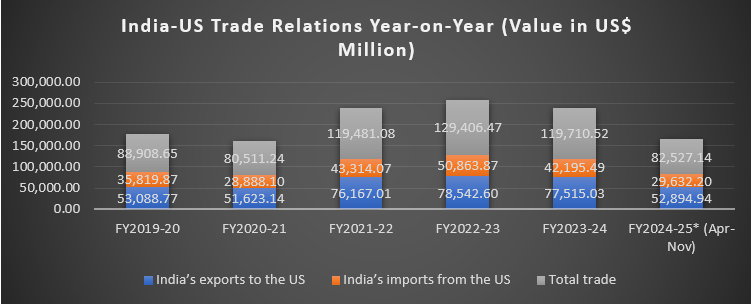
Source – Ministry of Commerce and Industry
Trump tariffs and US-India Trade deficit
As part of his economic policies, Trump announced a 25 percent tariff on all steel and aluminum imports, effective March 12, 2025. This move is expected to intensify global trade tensions and create challenges for steel exporters, including India.
Nomura analysts highlight that India’s weighted average effective tariff on US exports is considerably higher than the US’s tariff on Indian exports. India’s high tariff rates, averaging 17 percent compared to the US’s 3.3 percent tariff, expose it to potential retaliatory measures. India’s food products, vegetables, textiles, and clothing sectors, could be most vulnerable to Trump’s tariff measures, according to media reports. Other major Indian exports to the US, include electrical machinery, gems and jewelry, pharmaceuticals, and autos, besides iron and steel. Tariffs, also referred to as customs duties, are taxes levied on imported goods. These duties are paid by importers to the government and are often passed on to consumers. For example, if a company imports a product worth US$100 with a 10 percent tariff, the final cost rises to US$110. Interestingly, on February 13, India slashed its import tax (customs duty + additional levy) on bourbon imports from 150 percent to 100 percent; the US is the primary exporter of bourbon whiskey to India. Countries impose reciprocal tariffs to counter trade barriers set by their partners. In 2018, when the US raised tariffs on Indian steel and aluminum, India responded by increasing duties on 29 US products. The US faces a significant trade deficit, particularly with China and India. In FY2023-24, its trade deficit with India reached US$35.31 billion; in 2024, the trade deficit was US$45.6 billion. To address this, the Trump administration has justified tariffs as a measure to curb imports.
India-US collaboration on the IMEEC corridor
Trump declared that India and the US agreed to work together on the development of the India-Middle East-Europe Economic Corridor (IMEEC). Calling it one of the most revolutionary trade corridors in history, Trump emphasized that the corridor would link India, Israel, Italy, and eventually the US through interconnected roads, railways, and underwater cables.
The IMEEC is crucial for bilateral interests, augmenting strategic supply chains and increasing security in economic, energy, and health sectors in India, Europe, and the Middle East,” said PM Modi after a project review with French President Emmanuel Macron earlier this week.
While meeting Modi, Trump stated: “We agreed to work together to help create one of the greatest trade routes in all of history. It will go from India to Israel to Italy and on to the United
States connecting our partners by ports, railways, and undersea cables. Many many undersea cables.”
Economic Tensions:
Tariff barriers
- US officials have been critical of India’s Tariff and non-tariff barriers
- In the past, President Trump has called India’s tariffs “unacceptable,” and has described India as the “king” of tariffs.
- Whereas in 2018 the US levied across-the-board import tariffs of 25 percent and 10 percent, on steel and Aluminium, respectively.
- India increased tariffs on Agricultural products from the US in retaliation.
Non-tariff Barriers
- India has been putting many Non-tariff restrictions on US products e.g.
- India’s restrictions on US daily products due to ‘blood-meal’, a protein-rich dietary supplement for cattle that utilizes blood from slaughtered animals.
GSP
- Following a public review process, the Trump administration removed India from the GSP program on the pretext that India is prohibiting “equitable and reasonable” access to its markets.
- The Generalized System of Preferences (GSP) was instituted in 1971. The 13 countries that grant GSP preferences are: Australia, Belarus, Canada, the European Union, Iceland, Japan, Kazakhstan, New Zealand, Norway, the Russian Federation, Switzerland, Turkey, and the United States of America.
- It is a preferential tariff system extended by developed countries (also known as preference-giving countries or donor countries) to developing countries (also known as preference-receiving countries or beneficiary countries). It involves reduced MFN Tariffs or duty-free entry of eligible products exported by beneficiary countries to the markets of donor countries.
Conclusion –
The bilateral trade between India and the United States has transformed into a strong and dynamic relationship based on deepening economic relations, rising flows of investments, and growing commercial interactions. Bilateral trade has grown significantly over the years, with the US becoming India’s largest trading partner. Sectors like technology, pharmaceuticals, defence, energy, and education have been instrumental in reinforcing economic cooperation. In addition, India’s IT sector, pharmaceutical exports, and expanding consumer base continue to draw US investments, while Indian demand for energy, high-tech products, and capital goods propels US imports.
In the future, the trade relationship between the two countries is set to grow substantially, with estimates of bilateral trade growing to US$ 300 billion by 2026-27. It is the key drivers of future India-US trade dynamics such as trade policy reforms, digital trade, supply diversification of chains, and greater cooperation in emerging domains of artificial intelligence, renewable energy, and defence technology that will drive the future of India-US trade. Tariff disputes, regulatory obstacles, and geopolitical risks are the major challenges that must be overcome through bilateral negotiations and economic strategic partnerships.
References –
- Balassa, B. (1965), “Trade Liberalization and Revealed Comparative Advantage”, Manchester School of Economic and Social Studies, 33, pp. 99-123.
- Report of the US-India CEO Forum (2006), US-India Strategic Economic Partnership. CRS Report for Congress (2005), India-USA Economic Relations. CRS Report for Congress (2009), India-USA” Economic Relations. India Embassy (2011), “Strengthening India-US Financial and Economic Partnership, India Review, Vol. Issue
- https://www.ibef.org/indian-exports/india-us-trade.
- https://www.drishtiias.com/daily-updates/daily-news-analysis/india-us-relations-5
- https://pwonlyias.com/upsc-notes/india-us-bilateral-relations/
- https://www.slideshare.net/slideshow/usindia-trade-relation/239580272
- https://economictimes.indiatimes.com/news/economy/foreign-trade/as-trumps-tariff-threats-get-louder-whats-next-for-india-us-trade-ties/articleshow/118154924.cms
- https://www.coursehero.com/file/227606865/Group-5-IGE-Assignmentpdf/
- https://www.india-briefing.com/news/india-us-relations-modi-trump-meeting-february-2025-outcomes-36185.html/
- https://www.usitc.gov/research_and_analysis/tradeshifts/2023/us_trade_industry_sectors_and_selected_trading
